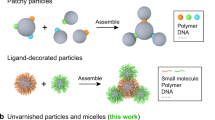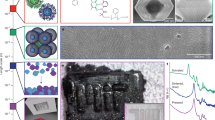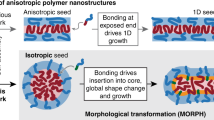Abstract
Precise control of the spatial organization of nanoscopic building blocks, such as nanoparticles, over multiple length scales is a bottleneck in the ‘bottom-up’ generation of technologically important materials. Only a few approaches have been shown to achieve nanoparticle assemblies without surface modification. We demonstrate a simple yet versatile approach to produce stimuli-responsive hierarchical assemblies of readily available nanoparticles by combining small molecules and block copolymers. Organization of nanoparticles into one-, two- and three-dimensional arrays with controlled inter-particle separation and ordering is achieved without chemical modification of either the nanoparticles or block copolymers. Nanocomposites responsive to heat and light are demonstrated, where the spatial distribution of the nanoparticles can be varied by exposure to heat or light or changing the local environment. The approach described is applicable to a wide range of nanoparticles and compatible with existing fabrication processes, thereby enabling a non-disruptive approach for the generation of functional devices.
This is a preview of subscription content, access via your institution
Access options
Subscribe to this journal
Receive 12 print issues and online access
$259.00 per year
only $21.58 per issue
Buy this article
- Purchase on Springer Link
- Instant access to full article PDF
Prices may be subject to local taxes which are calculated during checkout




Similar content being viewed by others
References
Aldaye, F. A., Palmer, A. L. & Sleiman, H. F. Assembling materials with DNA as the guide. Science 321, 1795–1799 (2008).
Balazs, A. C., Emrick, T. & Russell, T. P. Nanoparticle polymer composites: Where two small worlds meet. Science 314, 1107–1110 (2006).
Boal, A. K. et al. Self-assembly of nanoparticles into structured spherical and network aggregates. Nature 404, 746–748 (2000).
Glotzer, S. & Solomon, M. Anisotropy of building blocks and their assembly into complex structures. Nature Mater. 6, 557–562 (2007).
Huynh, W. U., Dittmer, J. J. & Alivisatos, A. P. Hybrid nanorod-polymer solar cells. Science 295, 2425–2427 (2002).
Li, Q. F. et al. Responsive assemblies: Gold nanoparticles with mixed ligands in microphase separated block copolymers. Adv. Mater. 20, 1462–1466 (2008).
Costanzo, P. J. & Beyer, F. L. Thermally driven assembly of nanoparticles in polymer matrices. Macromolecules 40, 3996–4001 (2007).
Alivisatos, A. P. et al. Organization of ‘nanocrystal molecules’ using DNA. Nature 382, 609–611 (1996).
Mirkin, C. A., Letsinger, R. L., Mucic, R. C. & Storhoff, J. J. A DNA-based method for rationally assembling nanoparticles into macroscopic materials. Nature 382, 607–609 (1996).
Bockstaller, M. R., Mickiewicz, R. A. & Thomas, E. L. Block copolymer nanocomposites: Perspectives for tailored functional materials. Adv. Mater. 17, 1331–1349 (2005).
Chiu, J. J., Kim, B. J., Kramer, E. J. & Pine, D. J. Control of nanoparticle location in block copolymers. J. Am. Chem. Soc. 127, 5036–5037 (2005).
Lin, Y. et al. Self-directed self-assembly of nanoparticle/copolymer mixtures. Nature 434, 55–59 (2005).
Mackay, M. E. et al. General strategies for nanoparticle dispersion. Science 311, 1740–1743 (2006).
Shenhar, R., Norsten, T. B. & Rotello, V. M. Polymer-mediated nanoparticle assembly: Structural control and applications. Adv. Mater. 17, 657–669 (2005).
Lopes, W. A. & Jaeger, H. M. Hierarchical self-assembly of metal nanostructures on diblock copolymer scaffolds. Nature 414, 735–738 (2001).
Thompson, R. B., Ginzburg, V. V., Matsen, M. W. & Balazs, A. C. Predicting the mesophases of copolymer-nanoparticle composites. Science 292, 2469–2472 (2001).
Bockstaller, M. R., Lapetnikov, Y., Margel, S. & Thomas, E. L. Size-selective organization of enthalpic compatibilized nanocrystals in ternary block copolymer/particle mixtures. J. Am. Chem. Soc. 125, 5276–5277 (2003).
Lauter-Pasyuk, V. et al. Effect of nanoparticle size on the internal structure of copolymer-nanoparticles composite thin films studied by neutron reflection. Physica B 241, 1092–1094 (1997).
Lee, J. Y., Thompson, R. B., Jasnow, D. & Balazs, A. C. Entropically driven formation of hierarchically ordered nanocomposites. Phys. Rev. Lett. 89, 155503 (2002).
Spontak, R. et al. Selectivity- and size-induced segregation of molecular and nanoscale species in microphase-ordered triblock copolymers. Nano Lett. 6, 2115–2120 (2006).
Matsen, M. W. & Thompson, R. B. Particle distributions in a block copolymer nanocomposite. Macromolecules 41, 1853–1860 (2008).
Glogowski, E., Tangirala, R., Russell, T. P. & Emrick, T. Functionalization of nanoparticles for dispersion in polymers and assembly in fluids. J. Polym. Sci. Polym. Chem. 44, 5076–5086 (2006).
Kim, B. J., Fredrickson, G. H. & Kramer, E. J. Effect of polymer ligand molecular weight on polymer-coated nanoparticle location in block copolymers. Macromolecules 41, 436–447 (2008).
Chiu, J. J. et al. Distribution of nanoparticles in lamellar domains of block copolymers. Macromolecules 40, 3361–3365 (2007).
Tsutsumi, K., Funaki, Y., Hirokawa, Y. & Hashimoto, T. Selective incorporation of palladium nanoparticles into microphase-separated domains of poly(2-vinylpyridine)-block-polyisoprene. Langmuir 15, 5200–5203 (1999).
Huh, J., Ginzburg, V. V. & Balazs, A. C. Thermodynamic behavior of particle/diblock copolymer mixtures: Simulation and theory. Macromolecules 33, 8085–8096 (2000).
Templeton, A. C., Wuelfing, M. P. & Murray, R. W. Monolayer protected cluster molecules. Acc. Chem. Res. 33, 27–36 (2000).
Hong, R., Fischer, N. O., Emrick, T. & Rotello, V. M. Surface pegylation and ligand exchange chemistry of FePt nanoparticles for biological applications. Chem. Mater. 17, 4617–4621 (2005).
Owen, J. S., Park, J., Trudeau, P. & Alivisatos, A. P. Reaction chemistry and ligand exchange at cadmium-selenide nanocrystal surfaces. J. Am. Chem. Soc. 130, 12279–12281 (2008).
Beard, M. C. et al. Variations in the quantum efficiency of multiple exciton generation for a series of chemically treated PbSe nanocrystal films. Nano Lett. 9, 836–845 (2009).
Kato, T. & Fréchet, J. M. J. Stabilization of a liquid-crystalline phase through noncovalent interaction with a polymer side-chain. Macromolecules 22, 3818–3819 (1989).
Antonietti, M., Conrad, J. & Thunemann, A. Polyelectrolyte-surfactant complexes—a new-type of solid, mesomorphous material. Macromolecules 27, 6007–6011 (1994).
Ruokolainen, J. et al. Poly(4-vinyl pyridine)/zinc dodecyl benzene sulfonate mesomorphic state due to coordination complexation. Macromolecules 28, 7779–7784 (1995).
Ober, C. K. & Wegner, G. Polyelectrolyte-surfactant complexes in the solid state: Facile building blocks for self-organizing materials. Adv. Mater. 9, 17–31 (1997).
Stewart, D. & Imrie, C. T. Toward supramolecular side-chain liquid crystal polymers. 5. The template receptor approach. Macromolecules 30, 877–884 (1997).
Ikkala, O. & ten Brinke, G. Hierarchical self-assembly in polymeric complexes: Towards functional materials. Chem. Commun. 2131–2137 (2004).
Ruokolainen, J. et al. Switching supramolecular polymeric materials with multiple length scales. Science 280, 557–560 (1998).
Valkama, S. et al. Self-assembled structures in diblock copolymers with hydrogen-bonded amphiphilic plasticizing compounds. Macromolecules 39, 9327–9336 (2006).
White, T. J., Serak, S. V., Tabiryan, N. V., Vaia, R. A. & Bunning, T. J. Polarization-controlled, photodriven bending in monodomain liquid crystal elastomer cantilevers. J. Mater. Chem. 19, 1080–1085 (2009).
Saariaho, M., Subbotin, A., Szleifer, I., Ikkala, O. & ten Brinke, G. Effect of side chain rigidity on the elasticity of comb copolymer cylindrical brushes: A monte carlo simulation study. Macromolecules 32, 4439–4443 (1999).
Ruokolainen, J. et al. Supramolecular routes to hierarchical structures: Comb–coil diblock copolymers organized with two length scales. Macromolecules 32, 1152–1158 (1999).
Lin, Y., Skaff, H., Emrick, T., Dinsmore, A. D. & Russell, T. P. Nanoparticle assembly and transport at liquid–liquid interfaces. Science 299, 226–229 (2003).
Kim, B. J. et al. Creating surfactant nanoparticles for block copolymer composites through surface chemistry. Langmuir 23, 12693–12703 (2007).
Kim, B. J., Fredrickson, G. H., Hawker, C. J. & Kramer, E. J. Nanoparticle surfactants as a route to bicontinuous block copolymer morphologies. Langmuir 23, 7804–7809 (2007).
Brode, W. R., Gould, J. H. & Wyman, G. M. Phototropism and cis–trans isomerism in aromatic azo compounds. J. Am. Chem. Soc. 74, 4641–4646 (1952).
Eisenbach, C. D. Effect of polymer matrix on cis–trans isomerization of azobenzene residues in bulk polymers. Makromol. Chem. 179, 2489–2506 (1978).
Acknowledgements
We thank T. P. Russell for the valuable discussions. SAXS experiments were carried out at beamline 7.3.3 at the Advanced Light Source. CoFe2O4 nanoparticle was provided by the Molecular Foundry at Lawrence Berkeley National Laboratory. This was supported by the Army Research Office STIR program under award No. W911NF-07-1-0653; NSF DMR-0805301; by the DuPont Young Professor Grant and by the 3 M Nontenured Faculty Grant. This work was also supported by the Director, Office of Science, Office of Basic Energy Sciences, of the US Department of Energy under Contract No. DE-AC02-05CH11231 through the ‘Organic-inorganic Nanocomposites’ programme at LBNL. H.J. acknowledges support from the Ministry of Education, Science, Sports and Culture through Grants-in-Aid No. 19031016, 21015017, 21106512 and 21241030.
Author information
Authors and Affiliations
Contributions
T.X. conceived and guided the project. Y.Z., K.T. and A.J.M. carried out sample preparation, measurements and data analyses detailed in the article. T.S. carried out the initial exploration and B.J.R. carried out the experiments using light responsive molecules. K.M. and H.J. carried out TEM tomography on select samples. J.M.L., Y.W. and A.P.A. provided the nanoparticles used. D.P. and J.M.J.F. synthesized the OPAP.
Corresponding author
Supplementary information
Supplementary Information
Supplementary Information (PDF 4494 kb)
Rights and permissions
About this article
Cite this article
Zhao, Y., Thorkelsson, K., Mastroianni, A. et al. Small-molecule-directed nanoparticle assembly towards stimuli-responsive nanocomposites. Nature Mater 8, 979–985 (2009). https://doi.org/10.1038/nmat2565
Received:
Accepted:
Published:
Issue Date:
DOI: https://doi.org/10.1038/nmat2565
This article is cited by
-
Hierarchically engineered nanostructures from compositionally anisotropic molecular building blocks
Nature Materials (2022)
-
Stimulus-responsive polymers for safe batteries and smart electronics
Science China Materials (2022)
-
Bowls, vases and goblets—the microcrockery of polymer and nanocomposite morphology revealed by two-photon optical tomography
Nature Communications (2021)
-
Phospholipid/protein co-mediated assembly of Cu2O nanoparticles for specific inhibition of growth and biofilm formation of pathogenic fungi
Science China Materials (2021)
-
Bidimensional lamellar assembly by coordination of peptidic homopolymers to platinum nanoparticles
Nature Communications (2020)



